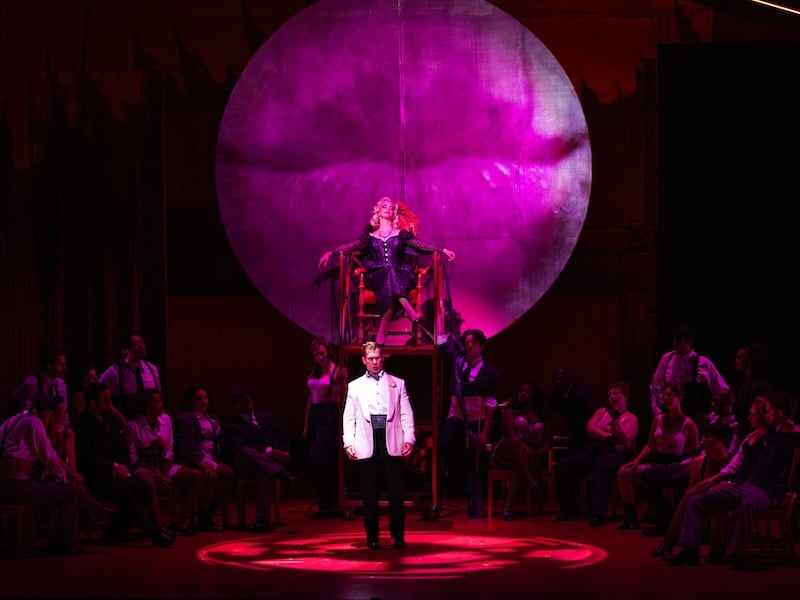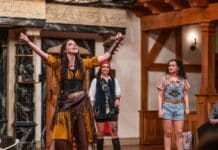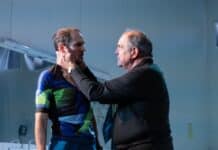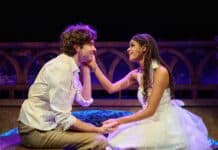Glorious music! Wonderful musicianship! The inclusion of Igor Stravinsky’s The Rake’s Progress in this their 50th Anniversary Season shows Glimmerglass Festival at its best, taking audiences for a pleasure ride through some great works of opera and music-theater. Glimmerglass also has become a proven model removed from the pressures of big metropolitan centers where economics of “the biz” all too often propel producing organizations to engage in transactional art-making and relationships. Instead, I believe here that artists are encouraged to take the time to nurture each other and nourish themselves and to re-imagine a work like The Rake’s Progress for today’s audience on a stage that draws everyone close so that when the side walls of the Alice Busch Theater slide open at the end, we find ourselves still cradled in a most bucolic setting.
Stravinsky’s opera pays tribute to the long tradition of this multi-disciplinary art form and celebrates music especially, which Conductor Joseph Colaneri most triumphantly realizes in leading the Glimmerglass Orchestra. Right from the start, with Stravinsky’s nod to Monteverdi, there’s a “Listen up” fanfare, and, under Colaneri’s baton, we’re off and running. The composer has also borrowed from Mozart in his orchestral composition and structure. At the same time, using a little theme that repeats, oscillating between major and minor, and by employing dissonance at times even in what is a tonal composition, Stravinsky places his music squarely in the camp of modernism.

Set Designer John Conklin picked up on the composer’s modernist intentionality and, rather than providing the setting called for at the story’s beginning — a garden on an 18th-century English country estate — he created a 20th-century painterly-and-sculpture “garden” of curved steel and discs and neon rods that change color from fiery red to magenta and blue during the course of the show. Conklin places all this against the reveal of the theater’s backstage, all pipes and mechanics exposed and everything sprayed red. It’s a 20th-century urban hell, make no mistake, and the production design telegraphs that man will have to pay for his greed, ambition, and carelessness.
The opera follows a Faustian tale of a fellow, Tom Rakewell, making a pact with the devil, selling his soul for power or pleasure or both. The devil in this opera comes in the character of Nick Shadow. Nick is a charmer, part worldly gentleman and part genie obsequiously promising to grant Tom three wishes, all the while reeling in his victim.
The Rake’s Progress is not an entirely easy piece, not on the listener’s ear, neither for the orchestra players to play nor for the singers to sing. It is a particularly Herculean task presented to the lead who, as the character of Tom Rakewell, must have the acuity and vocal stamina equivalent to a runner’s marathon. However, Adrian Kramer as Tom is more than up to the task and displays not just vocal alacrity and expression, but a certain acrobatic agility in expressing Tom’s irrepressible character and engages in some downright, cartoon-like physical clowning.
This muscular production highlights the physical genius of Eric Sean Fogel. Fogel, who has been associated with Glimmerglass for many seasons as Choreographer and Co-Director, steps up to fully direct and choreograph this show and has found in Kramer the perfect opera performer to realize his physicalized style of music-theater. In fact, the whole ensemble rises to the Fogelian challenge and plunges the hero into a teeming, roiling nightmarish world of lust and sadistic debauchery. The scene when Nick Shadow escorts the still naïve Tom to a London brothel is sin-sational! Kudos to the talented resident artists, led by Dance Captain Peter Murphy, a kinetic wonder!
As Nick Shadow, Aleksey Bogdanov is a fascinating performer to watch and a wonderful suave foil to the so-easily duped Tom. His velvety tones disarm and will lead on his man to doom or madness. Another marvelously drawn character is the bearded lady, Baba the Turk, with whom Tom, in his debauched delirium, is pressed into marriage. Deborah Nansteel, formerly in WNO’s Cafritz Young Artists’ Program, uses her beautifully supple voice and heartfelt sensibilities to present a complex, sympathetic portrait of a character today we might be wise to recognize as a non-gender conforming individual. (How did Stravinsky envision this character?) As Trulove, Anne’s father, Mark Webster represents the world of moral decency and ramrod societal norms. He’s a formidable old-world presence, who takes his daughter back into his sheltered world after her hopes for redemption through love unravel.
For Stravinsky to realize such an endeavor as this opera, it seems like destiny that he would share the task with a man who would become his friend and sometime philosophical sparring partner, W.H. Auden, the poet, who readily agreed to serve as Librettist. They were later joined by American poet and Auden’s lifelong lover Chester Kallman on the creative team. Although Auden as a man could be darkly complicated, his poetic sensibilities ran the gamut from philosophical, moral, and political — all which color this story — to romantic where he can even be delicate. This last side of Auden is best represented by the character of Anne Trulove, a morally good woman who forgives and follows her man to London to try and rescue him from his own weakness and growing moral bankruptcy.
As Anne, Lydia Grindatto gives a subdued and nuanced performance against the riot of more boisterously colorful characters, but this makes her role only more affecting, and her voice shines with a purity and strength that define her character. Auden’s writing for her character spins pure gold in places, providing a text imminently singable.
It was a great privilege to see and hear this work, so artfully realized. Sad to think there are only five performances left.
The Rake’s Progress (plays through August 15, 2025)
Running Time: Two hours and 44 minutes plus a 25-minute intermission.
Conductor – Joseph Colaneri
Director and Choreographer – Eric Sean Fogel
Set Designer – John Conklin
Costume Designer – Lynly A. Saunders
Lighting Designer – Robert Wierzel
Projection Designer – Greg Emetaz
With Adrian Kramer, Lydia Grindatto, Aleksey Bogdanov, Deborah Nansteel, Mark Webster, Tzytle Steinman, and Kellan Dunlap plus the Glimmerglass Ensemble and Orchestra
Tickets are available at glimmerglass.org.
SEE ALSO:
2025 Glimmerglass Festival Review: ‘Sunday in the Park with George’ and ‘The House on Mango Street’
2025 Glimmerglass Festival Review: ‘Tosca’
(reviews by Susan Galbreaith)



